Setup Studio Clustering with Kubernetes Deployment 
A Kubernetes deployment describes an applications life cycle, e.g. images to be used, the number of pods, etc. It creates pods based on a specified template. CrafterCMS has an example kubernetes deployment for a Studio cluster with 2 nodes and a Studio Arbiter. In this section, we’ll take a look at this example Kubernetes deployment.
Requirements
You need to have a Kubernetes cluster, and the kubectl command-line tool must be configured to communicate with your
cluster. If you do not already have a cluster, you can create one by using Minikube:
https://github.com/kubernetes/minikube.
The nodes in your cluster should at least have 4 CPUs and 8 GB of space, to avoid performance issues and out of memory
errors. In Minikube, to start a node with this characteristics, you can run a command similar to the following:
minikube start --cpus 4 --memory 8192.
The requirements (listed above) is the same as specified in Deploying a Simple CrafterCMS installation in Kubernetes. In addition to that, we need the following:
k9s for viewing the status of the pods, the logs, etc
Kubernetes deployment files for CrafterCMS Authoring cluster, found here: https://github.com/craftercms/kubernetes-deployments/
➜ git clone https://github.com/craftercms/kubernetes-deployments.git
The deployment files that we need for our example is under the
kubernetes-deployments/authoring/clusterfolder:kubernetes-deployments/authoring/cluster nodes/ authoring-deployment.yaml hazelcast-rbac.yaml kustomization.yaml resources/ config/ studio/ hazelcast-config.yaml studio-config-override.yaml secrets/ .ssh/ config arbiter/ arbiter-deployment.yaml kustomization.yaml resources/ config/ hazelcast-config.yaml
The
nodesfolder contains the deployment files for setting up two authoring pods and hazelcast, which is used as an in-memory distributed data store to orchestrate the bootstrapping of Studio’s Cluster.The
arbiterfolder contains the deployment files for hazelcast and the Studio Arbiter, an arbitrator that functions as an odd node, since our authoring deployment only has two nodes, to avoid split-brain situations.
Setup Kubernetes Secrets
From https://kubernetes.io/docs/concepts/configuration/secret/
"Kubernetes Secrets let you store and manage sensitive information, such as passwords, OAuth tokens, and ssh keys."
The deployment files cloned from https://github.com/craftercms/kubernetes-deployments/ has a folder set aside for placing confidential information, kubernetes-deployments/authoring/cluster/nodes/resources/secrets
This is where we will place the enterprise license to be used by the images in the deployment. Remember to name your license file to crafter.lic
This guide details setting up Authoring pods in a cluster, but once you setup the Delivery pod, it will need SSH access to the Authoring pods to pull site content. For this, you need to generate an SSH public/private key pair for authentication and provide the key pair as a Kubernetes Secret to the Pods.
Create the SSH Keys Secret
Go to
kubernetes-deployments/authoring/cluster/nodes/resources/secrets/.ssh. This is where we will create the ssh keys.Run
ssh-keygen -m PEM -b 4096 -t rsa -C "your_email@example.com"to generate the key pair. When being asked for the filename of the key, just enterid_rsa(so that the keys are saved in the current folder). Do not provide a passphrase.Note
Crafter requires the key to be
RSAand does not support keys generated using an algorithm other thanRSA. The Jsch library that Jgit uses only supportsRSAand does not support other keys such as OpenSSH. Make sure when you generate the key to specify the type asrsa:➜ ssh-keygen -m PEM -b 4096 -t rsa -C "your_email@example.com"
Check that the file starts with the following header:
-----BEGIN RSA PRIVATE KEY-----to verify that the key is usingRSA. Crafter also currently doesn’t support using a passphrase with SSH keys. Remember to NOT use a passphrase when creating your keys.Create a copy of the public key and name it
authorized_keys➜ cp id_rsa.pub authorized_keys
Start the Cluster
The next step is to start the cluster. When starting the cluster, remember to start the nodes first then the arbiter.
Start the nodes
Go to kubernetes-deployments/authoring/cluster/nodes then run kubectl apply -k .
➜ kubectl apply -k . clusterrolebinding.rbac.authorization.k8s.io/default-cluster unchanged configmap/authoring-studio-config-8ttt252b8f created secret/authoring-crafter-license-f2tf6946hb unchanged secret/authoring-ssh-keys-t4gb554959 unchanged service/authoring-service-headless unchanged service/authoring-service unchanged statefulset.apps/authoring configured
Check the status of the deployments by running kubectl get deployments, and the status of the Pods by running kubectl get pods. Here’s a sample output when running kubectl get pods:
➜ kubectl get pods NAME READY STATUS RESTARTS AGE authoring-0 2/4 Running 0 87s authoring-1 2/4 Running 0 87s
Another way of checking the status of the deployments/pods/etc. is by running k9s on the command line, which will open up a text-based user interface:
➜ k9s
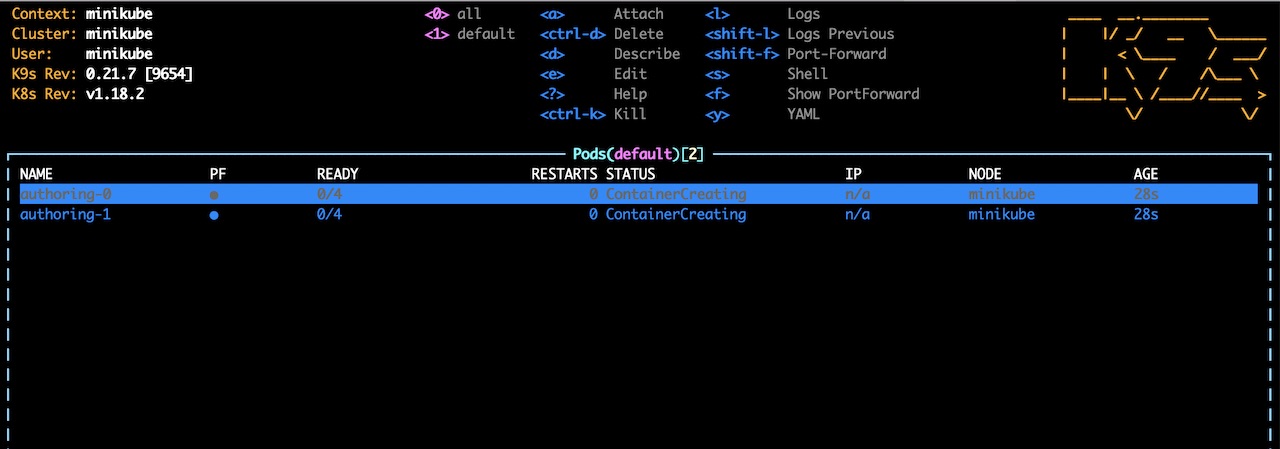
Once it comes up, you will see the two new pods created.
You can tail the logs of the tomcat and deployer containers, with the kubectl command:
kubectl logs -f -c CONTAINER_NAME POD_NAME
For example: kubectl logs -f -c tomcat authoring-deployment-5df746c4d8-lv9gd
To view the logs in a pod using k9s, from the Pods view, select the pod you would like to view the logs of using your keyboard arrow keys, then hit enter to view the containers in the pod.

We’ll take a look at the tomcat logs, so, we’ll move the cursor to the tomcat container, then press the letter l.
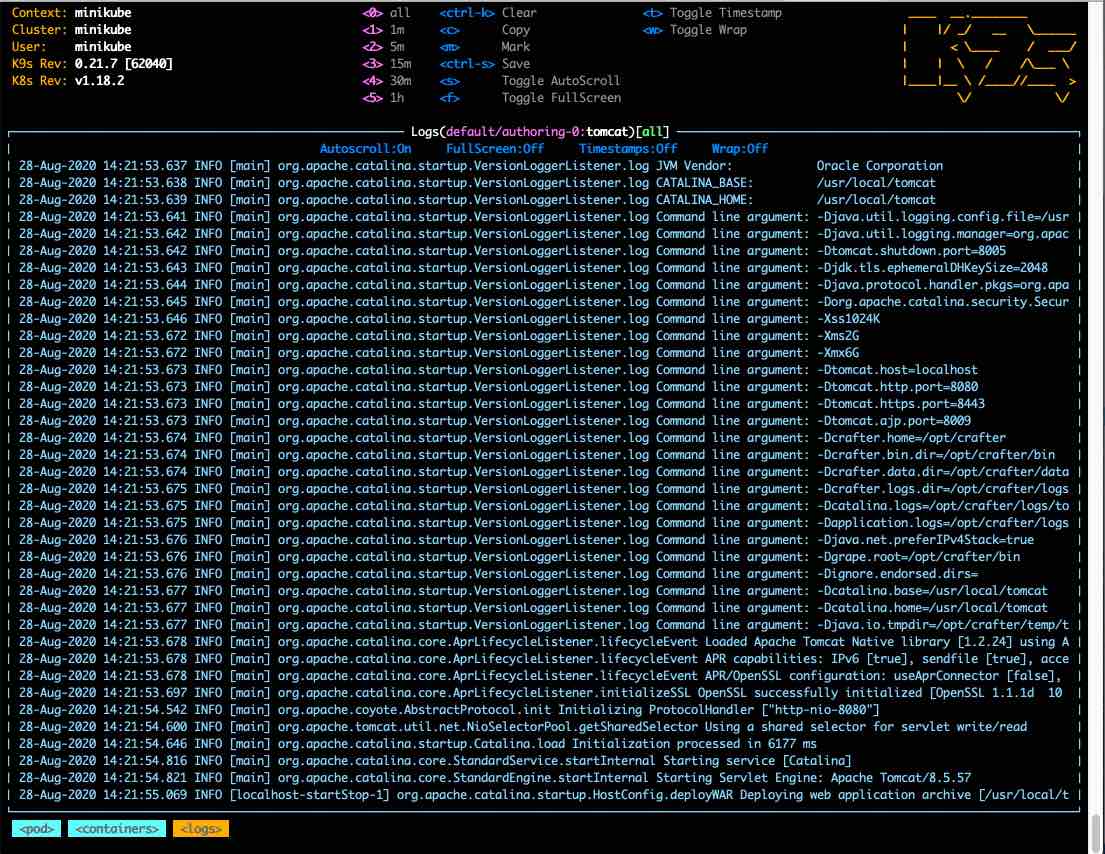
Start the arbiter
Go to kubernetes-deployments/authoring/cluster/arbiter then run kubectl apply -f .
➜ kubectl apply -f . configmap/arbiter-config-d6mbk26fgm created service/arbiter-service created deployment.apps/arbiter created
Check the status by running kubectl get pods and you should see the arbiter listed
➜ kubectl get pods NAME READY STATUS RESTARTS AGE arbiter-f84d677c7-v6gkx 0/1 Running 0 38s authoring-0 4/4 Running 1 9m31s authoring-1 4/4 Running 1 9m31s
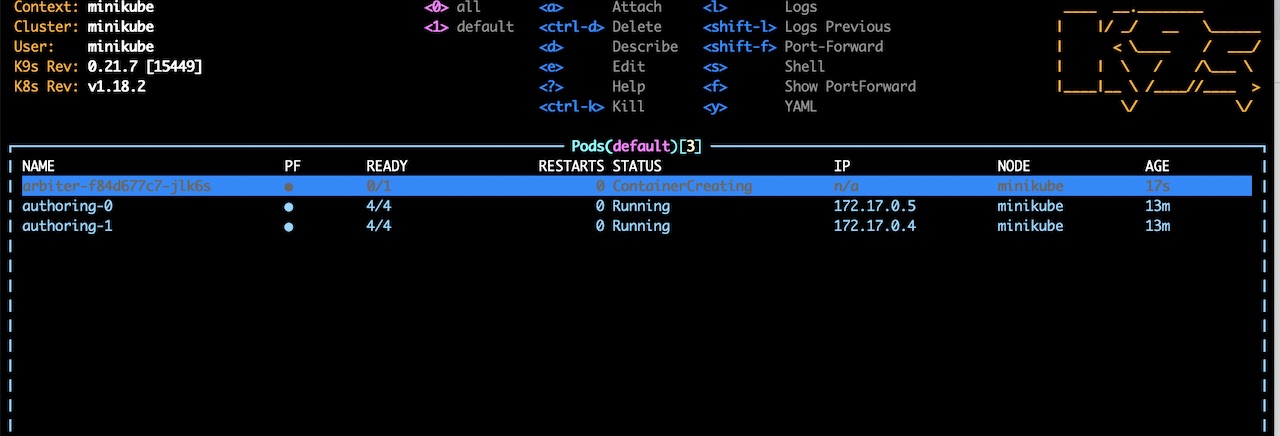
Create a Site
To be able to access applications in a cluster in Kubernetes, we need to use port forwarding. To access Studio, we will forward a local port to the tomcat port in the pod. We will forward local port 8080 for the tomcat container in the first pod, and local port 8081 for the tomcat container in the second pod.
kubectl port-forward allows using resource name, such as a pod name, to select a matching pod to port forward to. To forward a local port to a port of a pod, run the following:
kubectl port-forward pods/POD_NAME LOCAL_PORT:POD_PORT
Here’s an example forwarding local port 8080 to the tomcat in the authoring-0 pod:
➜ kubectl port-forward pods/authoring-0 8080:8080 Forwarding from 127.0.0.1:8080 -> 8080 Forwarding from [::1]:8080 -> 8080
To forward a local port to the tomcat port in a pod using k9s, from the Pods view, select the pod you would like to port forward to using your keyboard arrow keys, then hit enter to view the containers in the pod. We’ll forward the local port to the tomcat port, so, we’ll move the cursor to the tomcat container, then press <shift> + f. A dialog will then open where you can enter the desired local port and address to use for port forwarding
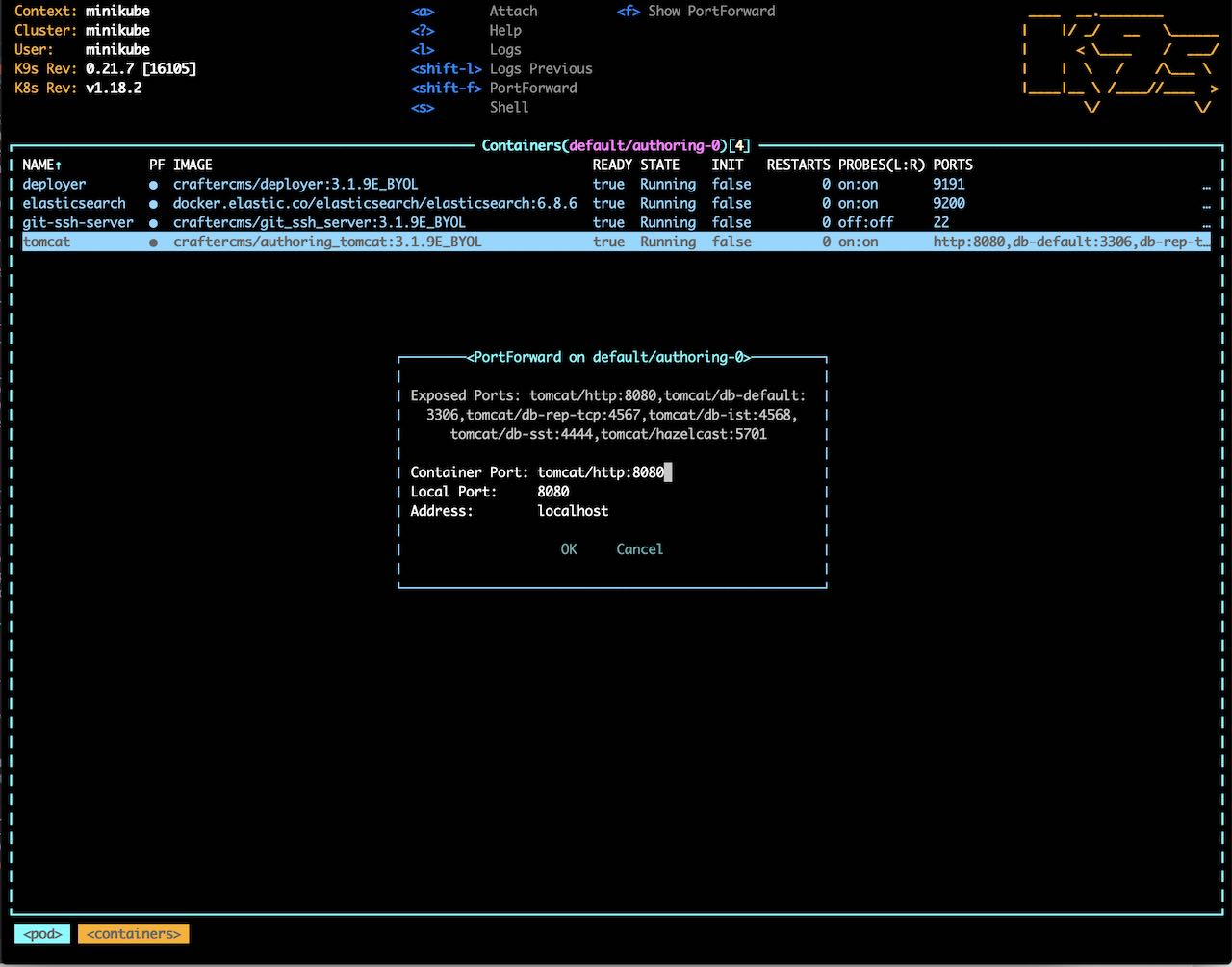
Change the value of Local Port to your desired value. For our example, we’re using local port 8080 for the authoring-0 pod and local port 8081 for the authoring-1 pod. After making desired changes, move the cursor to Ok then hit the enter key to save your changes.
We can now access Studio from either pods using localhost:8080/studio or localhost:8081/studio in your browser

If we look at the Cluster through one of the nodes, you’ll see the two nodes listed like below:
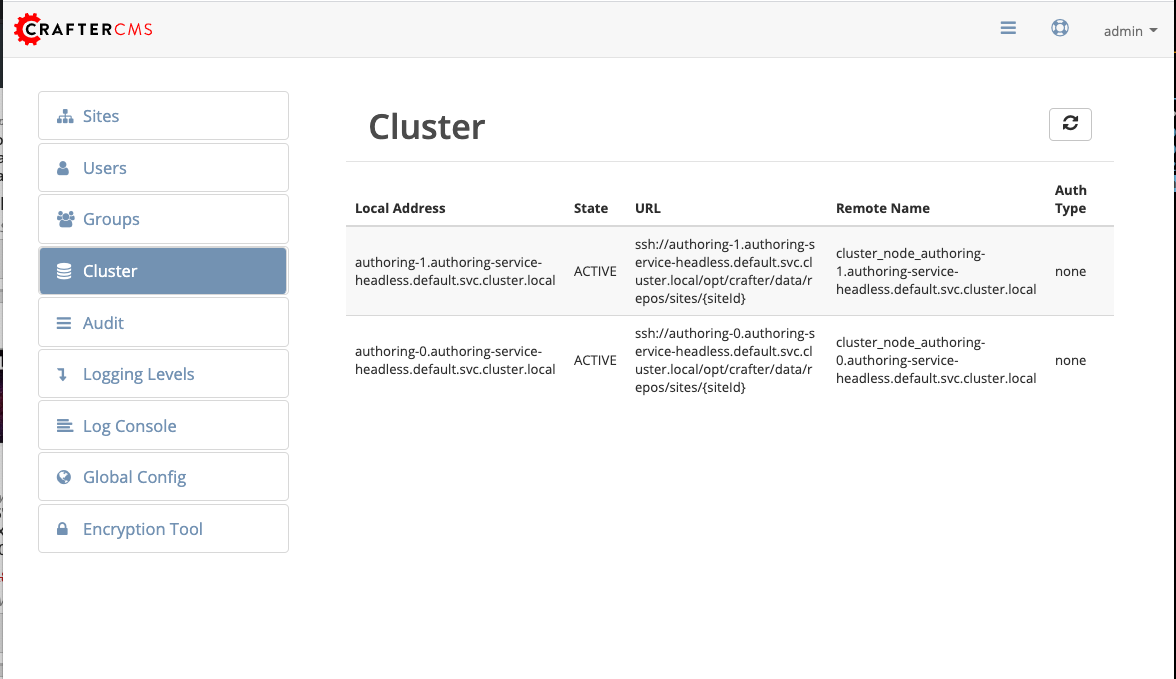
Shutdown the Cluster
When shutting down the cluster, remember to shutdown the arbiter first, then the nodes.
Shutdown Arbiter
We’ll shutdown the arbiter first, so go to the arbiter directory kubernetes-deployments/authoring/cluster/arbiter then run kubectl delete -k . This will delete resources (deployment, service, config map, stateful set) from a directory containing kustomization.yaml
➜ kubectl delete -k . configmap "arbiter-config-d6mbk26fgm" deleted service "arbiter-service" deleted deployment.apps "arbiter" deleted
Once the arbiter has been completely terminated, we can now start shutting down the nodes.
When we look at k9s, notice that the arbiter pod is no longer listed

Shutdown Nodes
To shutdown the nodes, go to the nodes directory kubernetes-deployments/authoring/cluster/arbiter then run kubectl delete -k . --cascade=false. Again, this will delete resources (deployment, service, config map, stateful set) from a directory containing kustomization.yaml
➜ kubectl delete -k . --cascade=false clusterrolebinding.rbac.authorization.k8s.io "default-cluster" deleted configmap "authoring-studio-config-8ttt252b8f" deleted secret "authoring-crafter-license-hghgcdd8f6" deleted secret "authoring-ssh-keys-t4gb554959" deleted service "authoring-service-headless" deleted service "authoring-service" deleted statefulset.apps "authoring" deleted
Shutting down the nodes one by one allows for a graceful shutdown of the cluster. The cascade flag allows killing the pods (shutting down the nodes) one by one. Remember to set the cascade flag to false, otherwise it will kill both pods at the same time.
The next step is to terminate the pods one by one. Terminate one pod first. Make sure the pod has completely terminated, then terminate the remaining pod.
Using k9s, we’ll delete the authoring-0 pod. Move the cursor to the authoring-0 pod, then hit the <ctrl> + d keys on your keyboard. A dialog will come up to verify deleting the pod. Move the cursor to OK then hit enter.
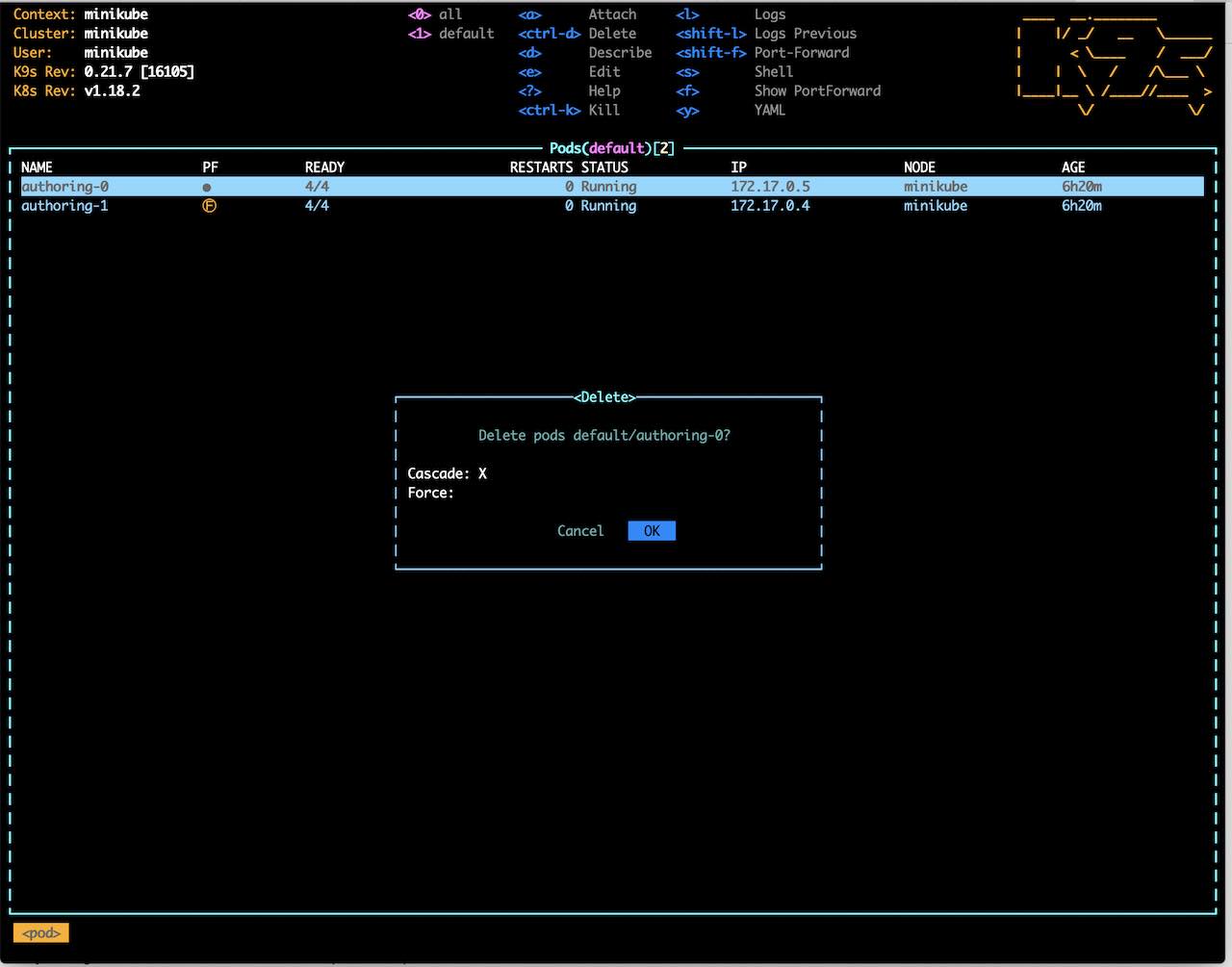
Wait until the pod has finished terminating, then we can terminate the remaining pod.

We can now delete the remaining pod authoring-1 by following the steps above using k9s or, you can also run kubectl delete pods <pod_name> to delete
➜ kubectl delete pods authoring-1 pod "authoring-1" deleted
For more information on the CrafterCMS Authoring Cluster, see the README.md file here: https://github.com/craftercms/kubernetes-deployments/tree/master/authoring/cluster